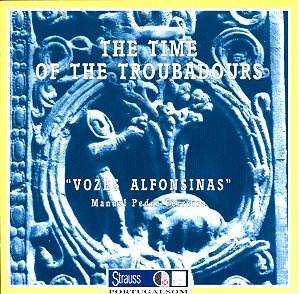 |
THE TIME OF THE TROUBADOURS 12th, 13th and 14th Century Songs from Spain and Portugal by Alfonso el Sabio (1221-1284) Dom Dinis de Portugal (1261-1324) Andre Dias de Lisboa Martin Codax and others. Vozes Alfonsinas directed by Pedro Ferreira Recorded in St.George's Church, Lisbon, October 1999 |
The title is in fact rather misleading. You might be correct to infer that music at 'the time of the troubadours' would probably be French, however this CD consists entirely of Spanish and Portuguese music calling to our attention "the Arabic-Andalusian songs and the cantigas composed in Galego-Portuguese also called the Galician-Portuguese language". I quote from the excellent CD notes written by the director of the ensemble Manuel Ferreira. These are Portuguese musicians recording for an enterprising and small label. If that sounds a little unusual then don't worry because the music is charming and beautiful and most musically and thoughtfully performed. Let me explain further.
The CD opens with the earliest music; three songs from Al-Andalus (the southern tip of the Iberian Peninsula, Islamic since the 8th Century). They demonstrate the Andalusian courtly tradition of Morocco, which, after all, is only just across the water. The instrumental accompaniment is ideal, two north African instruments: the alaude (a lute) and a drum called a derbuka. To give consistency these instruments are used throughout the recording. Dating from the 12th Century the songs are the musical equivalent of that great Moorish edifice in Granada the Alhambra palace which retains work of the same period. Moroccan or Moorish influence can also be heard in the later Cantiga "Todolas coitados" being in quintuple time
The disc has 18 tracks but contains six songs from the 'Cantigas de Santa Maria'. This is a collection recorded by many others over the years. From that collection Ferreira deliberately selected, songs, which refer to events and miracles "placed in the Portuguese territory... supposing Portuguese participation direct or indirect in their composition". There are preserved 427 cantigas in a superb manuscript which I have been lucky enough to see. The manuscript is accompanied by over one thousand illustrations. The Cantigas collection manuscript is dedicated to the blessed Virgin Mary and must have been composed in the second half of the 13th Century under the direction of King Alfonso X, known as 'The Wise' who was then King of Castile. Each song tells of a miracle, which occurs after a prayer has been made to the Virgin, and these miracles can happen anywhere in the Spanish kingdoms. This approach is not unique, for example, the 'Cantigas de Jerez' (stories from that particular city) were gathered together by Eduardo Paniagua on a beautifully illustrated CD (SONY SK 60080) which I had to buy in Catalonia two years ago but which is now available in this country. Incidentally, most other recordings, for example by Jordi Savall and La Capella Reial de Catalunya (on Astree Auvidis E8508), give a general and contrasted selection.
The use of the Galician-Portuguese language for all of the cantigas is unique and was undoubtedly due to the fact that until the XV century it was the most courtly language for lyric poetry. Several of the poems present the King as a troubadour dedicated to his lady, the Virgin Mary. On occasions his parents are mentioned in equal reverence. However in reality only a small part of the collection is attributable to the King. His work was one of organisation, direction and correction, but the stylistic unity of the book as a whole is to his merit.
This disc has afforded me considerable pleasure, not least for the fact that there are nine singers involved (three women and six men), who share out the music fairly equally. The group's director has a particularly suitable and likeable voice. The instrumental participation is never obtrusive but always adds a subtle colour. Some songs are unaccompanied (e.g. the three Cantigas D'Amor by Dom Dinas de Portugal). This is because they have elaborate melodies which best stand on their own. The remainder have some sort of instrumental participation sometimes including a delightful wooden flute.
Oddly, the Cantiga by Martin Codax (fl.1300) "Quantas sabedas" which could have been sung is the only piece on the CD which is played instrumentally.
Particularly enjoyable was the artists' approach to the cantiga "Maravilho- m'eu com'ous" which tells the story of how the virgin protected eight warriors "from some doings with the moors". The story is narrated by a soprano (here it is the versatile Susana Teixeira). The warriors are sung by three male voices, often in parallel organum and sometimes with lute accompaniment. This song, like some others, includes some spoken text as was, it is believed, the custom at the time.
The remainder of the recording consists of later medieval songs a group of which are from the Algarve. Another group comprises women's songs. One song is based on an Italian Lauda being about St. Lawrence (by Andre Dias de Lisboa 1348-1450) the refrain of which is given a drone vocal backing. The last track, the women's songs, is for me the least successful. The three are heard separately but also sometimes together, and one of them being somewhat chromatic creates some out of keeping harmonies. It is a curious ending to an otherwise beautifully put together and conceived release, which I would heartily recommend to any lover of early music.
Full texts and translations are given and the performers clearly identified for each track
Gary Higginson
ORDERING
For UK --- £6 each
Freight --- up to 3 CDs --- not registered --- £2.40; registered---- £3.50
For USA --$ 10 each
Freight --up to 3CDs -- not registered ---$5; registered ---- $6.80
Strauss accept Visa or American Express
Orders: for the attention of Eduarda Martins
by fax to the nş 351217141723By mail to:
Rua Adelaide Cabete,3C
1500-023 LISBOA
Portugal
by e-mail to: info@strauss.pt